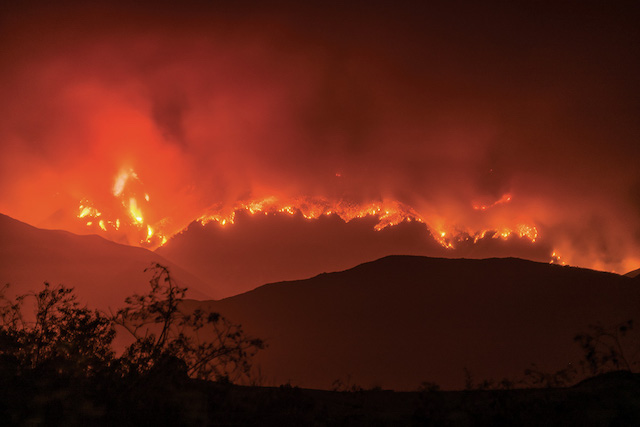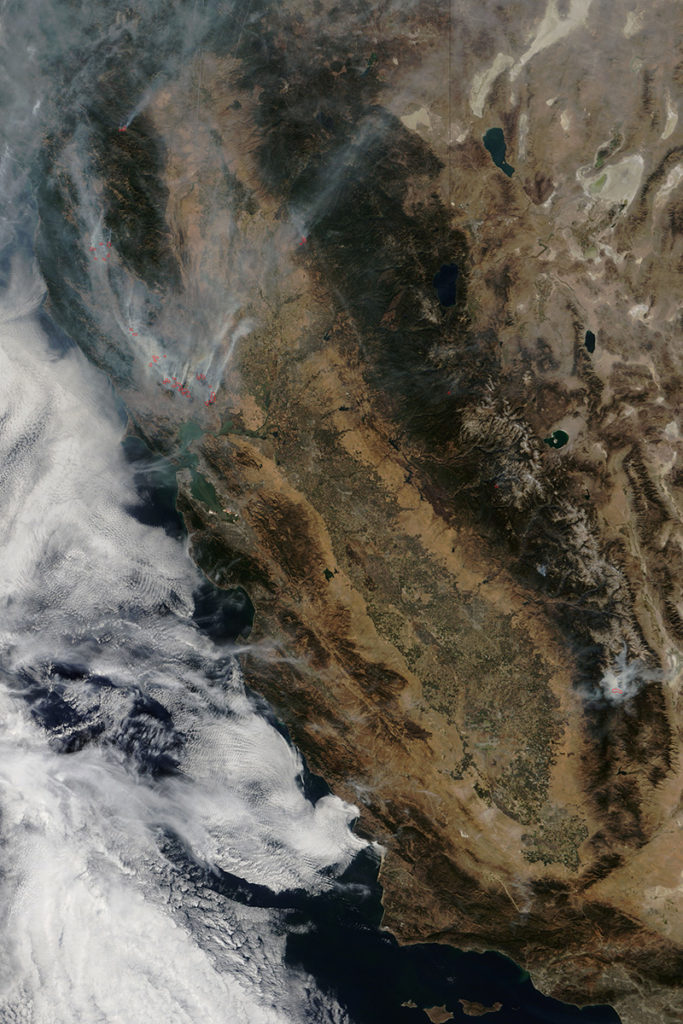Dozens of large wildfires burned more than 8 million acres of the American West this summer, bringing along with them smoke, ash, and unhealthy air conditions. And now deadly fires are burning in northern California. The fierce blazes that scorched through Napa and Sonoma counties in October were devastating, consuming more than 200,000 acres and claiming at least 42 lives.
If it feels like large wildfires are becoming more common these days, that’s because they are. Over the past decade, wildfires in the United States have burned an average of 6.6 million acres each year, twice the annual average during the 1990s. And the price tag for fighting them is growing as well. The federal government spent more than $2.7 billion fighting wildfires in the most recent fiscal year, exceeding the previous record of $2.1 billion, set in 2015.
In recent years, these high wildfire-suppression costs have forced federal land agencies to divert funding from other forest-related projects, including fire prevention. This practice, known as “fire borrowing,” has sparked efforts by lawmakers from both sides of the aisle to want to reform wildfire policy, though there is no consensus on what the reforms should look like.
Wildfires are a complex policy issue, with many underlying factors that are difficult to untangle. It’s common to blame climate change, and indeed there is little doubt that warmer temperatures, longer wildfire seasons, and more frequent droughts will make fires worse. But that’s hardly the only factor at play. Our policy responses to wildfires and our land-management practices are equally important, if not more so.
A primary issue is federal forest management. For more than a century, the dominant U.S. policy has been to suppress all fires (think of Smokey the Bear’s famous fire-prevention campaign). While this policy has made fires less frequent, it has also caused dramatic changes in forest conditions, which now pose even greater risks when fires do occur. Many forests that once burned frequently in low-intensity fires have not burned in decades and as a result have become dense and overgrown, making them more susceptible to damaging fires or deadly insect outbreaks that can turn huge numbers of living trees into highly combustible tinder. With conditions like these, all it takes is a few weeks of hot, dry weather and some wind to create a serious fire danger.
Large wildfires can have severe consequences for local communities. California’s headwater forests, which are the source of two-thirds of the state’s surface-water supply, are now at a high risk of burning, according to a new report by the Public Policy Institute of California. Since 1930, the density of small trees in these forests has doubled, creating dangerous fuel loads. And now, after years of drought, many of those trees are dying, with a five-fold increase in insect-related tree mortality since 2014. This has created ideal conditions for massive firestorms that could contaminate the watersheds with sediment and ash, clog intakes, and cut off water supplies to local communities. “More active management of these lands is needed to improve forest health,” according to the PPIC, primarily “the strategic removal of high-density smaller trees.”
For more than a century, the dominant U.S. policy has been to suppress all fires. While this policy has made fires less frequent, it has also caused dramatic changes in forest conditions, which now pose even greater risks when fires do occur.
Despite the need to reduce fuel loads—the amount of trees available to burn—in our forests, environmental laws often prevent much-needed projects, such as selective thinning to mimic the effects of fire (which in some cases also provides lumber for commercial uses) and prescribed burns in which fires are intentionally set and controlled to manage vegetation. Laws such as the National Environmental Policy Act and the Endangered Species Act require lengthy planning for such projects, usually accompanied with endless litigation by environmental groups seeking to halt them. This “analysis paralysis,” as one former Forest Service chief described it, wraps agencies in a tangle of red tape that can thwart even the most basic forms of land management. Timber harvesting on federal lands has declined by 80 percent since 1990, primarily due to these laws, leaving even more fuel to burn.
Consider a proposed fuel-reduction project near Bozeman, Montana, that has been delayed since 2012, with no end in sight. The U.S. Forest Service planned to thin 3,000 acres of dense forests and conduct prescribed burns on another 1,575 acres to protect the city’s water supply from the effects of a catastrophic fire. A pair of environmental groups sued, arguing that the project would threaten critical habitat for the Canadian lynx, a federally protected species. A judge ruled that the U.S. government had not properly considered this issue, and the project remains tied up in court. One can only hope the outcome will be better than it was in the nearby Helena-Lewis and Clark National Forest, where the same groups halted a similar fire-mitigation project earlier this year only to see large portions of the forest go up in flames this summer.
Yet another factor behind the recent increase in costly wildfires has to do with the incentives that our wildfire policies create. For one thing, federal agencies have virtually no limitations on spending when it comes to fighting fires. Since the early 20th century, Congress has allowed the Forest Service to devote any amount of funds it wants to fire suppression, although it often has to temporarily raid its other non-suppression accounts to do so; if the agency exceeded its budget, Congress reimbursed those expenditures the following year. That has created a thorny problem: Agencies are severely constrained in their ability to manage their forests to prevent wildfires, but they have a blank check to spend on wildfire suppression once the burning starts.
In recent years, this policy has caused the Forest Service to shift its focus from managing forests to fighting fires, prompting former agriculture secretary Tom Vilsack to joke that the agency had become “the Fire Service.” In 2001, as the timber harvest reached a record low, the agency sought to dramatically increase its appropriations for wildfire suppression. In response to a relatively active wildfire season the year before, the Clinton administration had obliged and nearly tripled the amount of funding, which has remained high ever since. Today, wildfire-related appropriations make up more than half of the Forest Service’s total budget. Current policies provide no incentive for cost-saving and in fact may be encouraging wasteful spending. This is perhaps most evident in the widespread use of aircraft-delivered salvos of fire retardant, which some have dubbed “CNN drops” because they are highly visible but mostly ineffective against large fires. The use of backfires, a costly and damaging technique in which firefighters burn down trees in the path of a fire before the fire can reach them, has also been criticized as a visible yet inefficient suppression strategy. But once a large fire is burning, something must be done, and such tactics have political appeal.
As economists Dean Lueck and Jonathan Yoder have noted, the recent increase in suppression funding makes policy assessment difficult: Did larger fires lead to larger suppression budgets, or did larger suppression budgets (and less active forest management) lead to larger fires and more suppression expenditures? That question is lost on most commentators and policymakers, who generally assume that simply throwing more money at wildfire suppression will solve the problem. “We need to fully fund [the fighting of] wildfires, not clear-cut more forests,” Representative Raúl Grijalva of Arizona, the top Democrat on the Natural Resources Committee, recently said.
The ongoing debate over fire borrowing is particularly susceptible to such thinking. Lawmakers are currently considering several bills to reduce fire borrowing by allowing wildfire suppression to be funded out of federal accounts for other natural disasters such as hurricanes and tornadoes.
A bipartisan group of western senators, led by Democrat Ron Wyden of Oregon, has introduced one such bill. But while this would allow agencies to avoid temporarily raiding other accounts to fund suppression efforts, the proposal would do nothing to change the incentives that lead to overinvestment in wildfire suppression, nor would it alter the sweeping environmental laws and regulations that prevent agencies from conducting pre-fire management on the ground. It could even worsen the perverse incentives: Federal natural-disaster spending programs, such as flood insurance, have the pernicious effect of encouraging more people to live in harm’s way, at considerable taxpayer expense. In the case of wildfires, more suppression spending would simply encourage more people to live in the high-risk wildland-urban interface.
Republicans are demanding that any wildfire-budget fix be combined with provisions that would speed up approvals for forest-thinning projects. A bill proposed by Representative Bruce Westerman (R., Arkansas) would exempt some thinning projects, up to 10,000 acres, from lengthy environmental reviews. A separate bill proposed by Montana senators Steve Daines (R.) and Jon Tester (D.) seeks to limit legal challenges to some forest-management projects that are stalled due to lawsuits over critical-habitat designations, removing obstacles to approximately 80 fuels-reduction projects, including the one near Bozeman. “If we don’t start managing our forests, the forests are going to start managing us,” Daines has said.
There are no easy answers. A more efficient wildfire policy would likely require the type of discipline that could be enforced only by a firm budget constraint. But a budget constraint for wildfire spending would be a political non-starter. People expect the federal government to act wherever and whenever forest fires start to burn.
Nevertheless, several important things could be done. Allowing agencies to “bank” unspent funds instead of encouraging them to exhaust their suppression funds each year is one logical step. Reforming environmental laws to allow for more-active forest management, such as thinning and prescribed burning—or providing exemptions to those laws for these purposes, as some lawmakers have proposed—would also help. Most important is to reduce fire risk before fires even start. This requires removing highly combustible vegetation from fire-prone areas, “fire-proofing” at-risk properties by creating buffer zones around structures, and investing in “Firewise” preparedness programs, which encourage modifications to landscaping and building construction that can help protect homes and neighborhoods from devastating blazes like the ones that recently swept through California.
As fires become larger and more expensive, these issues will only get worse. To adapt Smokey’s slogan, only Congress can make the changes necessary to prevent catastrophic wildfires from becoming the norm—but unfortunately, many of the existing proposals are not likely to make things better.
© 2017 National Review. Used with permission.





